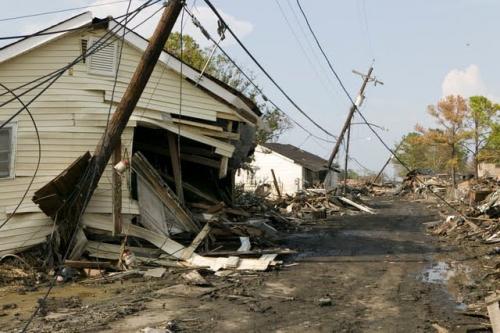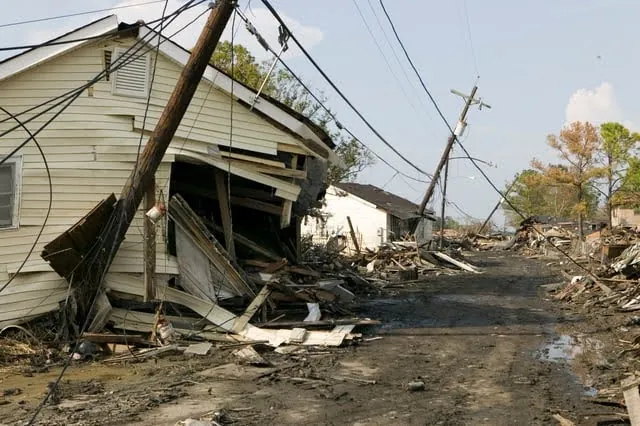
https://earthworks.org/blog/20-years-after-hurricane-katrina-devastated-...
Twenty years ago, Hurricane Katrina made landfall in Louisiana, taking roughly 1,800 lives and indelibly changing the landscape of the Gulf Coast. I remember helping to board windows, tie up swings on the swingset, and pack belongings as my family decided to evacuate New Orleans several days before the storm hit. At eight years old, I could tell by the fear in my parents’ voices that this wouldn’t be just another hurricane-imposed mini-vacation to visit cousins in Baton Rouge, like we were accustomed to taking a couple of times each summer. This storm would be much worse.
Two decades after the storm devastated New Orleans, the risk of an extreme weather event is worse than ever before. Since Trump has taken office, his agencies have been fast-tracking oil, gas, and petrochemical project approvals, which would be ticking time-bombs for Louisiana’s coastal communities. They pollute air and water harming human health and ecosystems; they destroy wetlands that protect inland communities from the brunt of hurricanes; and they emit climate-warming pollution that increases the severity and intensity of extreme weather events.
Among the facilities that are receiving licenses from this administration are “floating” LNG platforms, which are export terminals that sit on the water, often near the coast, directly in the path of hurricanes. When hurricanes hit, oil and gas facilities pose yet another risk for nearby communities. Toxic fumes, polluted flood waters and contaminated soil pose compound threats to communities in the path of the storm. Louisiana communities know this story all too well.
On August 25, 2025, an explosion at chemical manufacturer Smitty’s Supply in Roseland, LA; toxic fumes billowed into nearby communities. Grassroots community group RISE St. James captured a video.
A City Below Sea Level
When Katrina’s storm surge caused the levees to collapse, 80% of New Orleans became submerged. The levees broke in 53 different places, and over 100,000 of the city’s 1.3 million residents remained in the area. Many who did not have the means to evacuate became trapped in their attics or on roofs. Fires, looting, and a continually botched relief effort prevailed. As search and rescue efforts attempted to airlift people, tens of thousands more were stuck in the Super Dome for days on end.
The storm took roughly 1,800 lives and cost the Gulf Coast almost $200 billion in damages, making it the costliest storm in U.S. history to date. In New Orleans, 70% of all occupied housing units suffered damage. Months after the storm, 600,000 households across the region remained displaced. Katrina remains the costliest hurricane in U.S. history, with an estimated $198.6 billion in damages (adjusted for 2024 dollars).
On a normal day the city, which sits below sea level, is protected by a system of levees that keep the Mississippi River and other bodies of water at bay. Later, the Army Corps of Engineers admitted that the levee failure had happened in part due to flawed and outdated engineering practices used in construction. State budget cuts also meant that the decades-long project was yet to be completed when the storm hit.
Map of New Orleans levee breaches in Hurricane Katrina. Wikimedia Commons. 2006.
Broken Levees, Broken Systems
The disaster of Hurricane Katrine both epitomized and exacerbated deeply ingrained systemic challenges and systemic injustices faced by New Orleans, and South Louisiana, generally. A century of trying to contain the Mississippi River from natural flooding patterns has led to subsidence and soil erosion. Wetlands that protected the city are eroding at a pace of 1 football field per hour, due to dredging, saltwater intrusion and subsidence related to oil and gas infrastructure. As the planet warms, sea-levels rise; as sea-levels rise, islands and wetlands wash away, leaving less protection from the next storm.
Redlining and decades-old racist policies meant that the poorest people were living in the hardest-hit neighborhoods. Low- income Black families populated the Lower Ninth Ward, a neighborhood that sat below the water level of the neighboring Industrial Canal. Wealthy, white families owned mansions on the higher ground along the tree-lined St. Charles Avenue. When the levels failed, the Lower Ninth was almost entirely wiped out. Systemic economic inequity also meant that those who lacked access to vehicles and other resources necessary to evacuate were disproportionately Black, elderly, or very young.
Damaged homes in New Orleans’s Lower Ninth Ward neighborhood. Picryl. 2005.
Existing pollution and environmental injustice compounded the environmental health impacts of the storm. Floodwaters caused hazardous chemicals from nearby industrial sites to spill into local waterways, resulting in a dangerous mix of pollutants often referred to as a “toxic soup.” A lack of adequate planning for debris removal raised concerns about environmental injustice, potentially leading to long-term health impacts—especially for low-income and working-class populations. Existing and proposed petrochemical facilities – disproportionately sited in Black and low-income communities – lie in the pathway of Gulf coast hurricanes, compounding risks for nearby communities.
Politics Over People
As Trump and Republicans in Congress do everything in their power to dismantle environmental regulations and speed up new polluting fossil fuel projects, decision makers in Louisiana are dismantling key resilience programs and allowing polluters to go unchecked.
- Last month, Governor Jeff Landry cancelled the $3 billion Mid-Barataria sediment-diversion project that had been decades in the making. The plan represented a core part of the state’s Coastal Master Plan, aiming to rebuild 20 square-miles of wetland over the next 50 years.
- The 2025 Louisiana legislative session saw rollbacks on environmental protections, while increasing permitting requirements related to renewable energy, and advancing false solutions like carbon capture and sequestration.
- Trump has attempted to reallocate $4 billion from the Federal Emergency Management Agency (FEMA), an essential source of emergency relief for states in the wake of disasters, and signaled his intentions to “phase out” the agency after this year’s hurricane season, meaning slower and weaker disaster response for states.
This week, nearly 200 FEMA employees decried Trump’s “effective dissolution of FEMA itself,” which has included the impoundment of federal funds to the agency and the termination of key disaster preparedness grants. Trump’s cuts to the agency undo decades of progress for federal emergency response, leaving communities vulnerable to consequences at the scale of Hurricane Katrina when the next storm hits.
A Pathway Forward
Twenty years after Hurricane Katrina devastated the Gulf Coast, the risk of an extreme weather event is worse than ever before. Yet, we know what it will take to be ready and we know what it will take to protect one another from the worst effects of climate change. It’s time for politicians to stop giving polluter handouts; oppose new permits for climate-warming oil and gas facilities; develop community resilience projects; invest in sustainable infrastructure and renewable energy; and strengthen avenues for public participation in decision-making.
In Louisiana, our strength comes from our community. In the midst of every environmental disaster Louisianans rely on one another. This week, community organizations across the city are coming together to commemorate the disaster’s 20-year anniversary, by uplifting our stories, remembering lives lost, and charting a path forward towards sustainability and resilience. Check out some of the events!
- City of New Orleans K20 Event Calendar
- Taproot Earth Community-Sourced Week of Action Calendar
- Taproot Earth Katrina 20 Impact Rides
- Hip Hop Caucus Hurricane Katrina Annual March & Second Line
- NAACP Climate Justice for Black Communities Program











